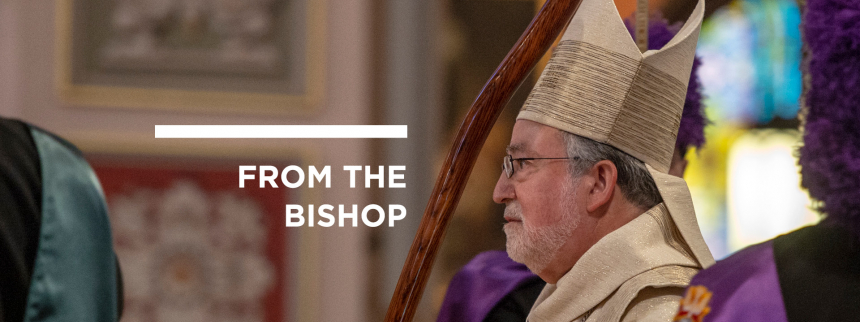
The infancy narrative of Luke simply says that Mary “gave birth to her firstborn son. She wrapped him in swaddling clothes and laid him in a manger, because there was no room for them in the inn.” (Lk 2:7) Through the centuries the Catholic imagination elaborated on this simple verse, creating a countless variety of scenes depicting the simple Lucan text.
The traditional Christmas crèche sometimes portrays the scene taking place in a stable. Other scenes place the Holy Family huddled in a cave. The manger is typically imagined as a wooden trough intended to hold hay for the feeding of domesticated farm animals. Nowhere in the Lucan narrative is there a mention of animals. Artists through the ages probably took their cue from the reference to the manger. If Jesus was laid in a manger, the thinking goes, then there must have been animals nearby.
Shepherds were an important part of Luke’s infancy story. When they rushed to the manger, certainly some of their sheep would have tagged along. Many manger scenes include a shepherd boy carrying a young lamb. That the shepherds knew where to find the manger also suggests that they were well acquainted with the place where their flocks could find food and water. Oxen and mules are other typical animal figures included in a Nativity scene.
The familiar carol, “The Little Drummer Boy,” tells us that “the ox and lamb kept time.” “Good Christians All Rejoice,” another popular carol, sings “Ox and ass before him bow.” These endearing images give the animals an innate instinct to reverence their eternal Creator born in time.
Were they gazing at the radiant beams coming from the holy child’s face or were they hungerly eyeing the hay upon which the infant rested? This was a puzzle with a purpose. Mary’s pragmatic maternal necessity to find a warm place to rest her newborn son on a chilly Judean night served another purpose in the greater design of divine wisdom. Jesus would indeed become food for the hungry.
As an adult, Jesus declared to the disciples after feeding the multitude, “I am the bread of life; whoever comes to me will never hunger, and whoever believes in me will never thirst.” (Jn 6:35) These words were true from the very first “Silent Night, Holy Night.” The Virgin Mother may have sown the seeds of this sacramental metaphor in the child’s developing mind as she recounted the story of his birth to the young Jesus during their years in Nazareth. The Lord’s own self-knowledge about his mission was being fashioned and foretold in the humble manger of Bethlehem.
The celestial convening of the shepherds tending their sheep had its greater purpose as well. Bethlehem was the birthplace of David, the great shepherd-king. It was also the place, only a short distance from Jerusalem, where religious Jews could obtain sheep for the ritual sacrifices in Jerusalem. Jesus, born in the town of David, was to be the “lamb led to the slaughter” (Is 53:7), the Lamb of God (Jn 1:36) who takes away the sins of the world. On that first Christmas night, the shepherds were summoned by choirs of angels to see the pure, unblemished Lamb that would someday be taken to Jerusalem for the holy Passover from the slavery of sin to the freedom of unending grace.
These brief reflections remind us that the Christmas mystery heralded the revelation of the eucharistic mystery. The Christmas Mass is tightly intertwined with story of the Lord’s Incarnation. The eucharistic altar is a Nativity scene all its own. The decorative images of the Christmas crèche, customarily displayed in all parish churches, are intended to serve as helpful reminders to stimulate our faith so that we may better see the beautiful reality of Christ Jesus placed upon the altar as heavenly food.
He is the eternal Lamb born of a Virgin in Bethlehem through whom all creation is reconciled “by the blood of his cross.” (Col 1:20) In the celebration of the sacrifice of the Mass we are drawn into the real events of salvation unfolding in awesome mystery. The Nativity crèche recedes from view as the radiant beams of charity flow from the altar. We behold the real presence of the Lamb of God who takes away our sins and the sins of the world.
Paul told the Colossians that Jesus “is the image of the invisible God, the firstborn of all creation.” (Col 1:15) Perhaps then, it was Pauline inspiration that brought an array of creation to the manger throne of Bethlehem. Sheep, oxen, mule, shepherds, stars, angels, and Magi came to contemplate in the arms of Mary the One through whom and for whom they were created. Jesus came to share in our humanity and to make his dwelling on this earth. By him, all the earth has truly become our common home. His great act of humble charity reminds us that we share in his saving work of restoring and redeeming all creation so that in harmony with the angels the whole earth may sing, “Glory to God in the highest!”

